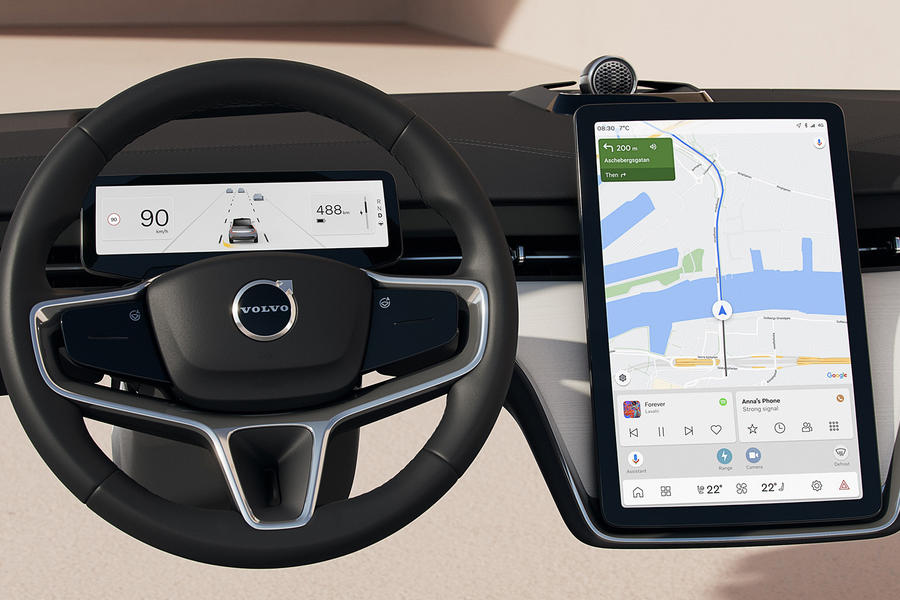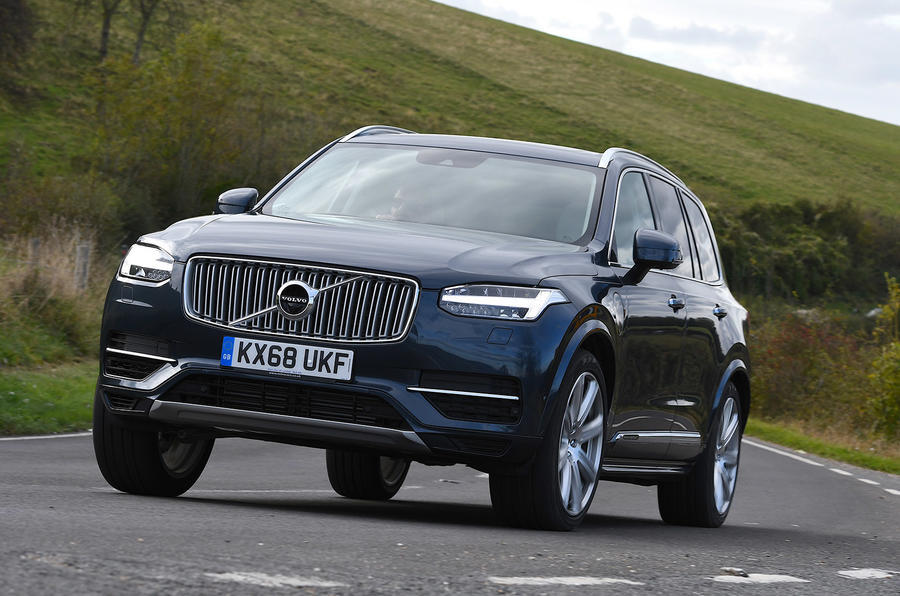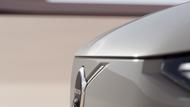Blanked-off grille matches smaller C40 and XC40 EVs
Range-topping Volvo EV to get innovative safety tech and use new SPA2 platform
Volvo’s range-topping new electric car, the EX90, has been previewed ahead of its full reveal at 2pm (GMT) today.
This car has now been revealed. Click through to the following link to read our story: New Volvo EX90 brings 360-mile range for £96,255
Set to go on sale next year, the electric SUV will be Volvo’s new flagship and the first to sit atop its new SPA2 platform. It will be kitted out with safety technology never before seen on a production vehicle and sold alongside a heavily refreshed version of the current XC90.
New images give little of the car’s final design away, but do hint at how important aerodynamic efficiency has been for the design team – Volvo claims a coefficient of 0.29Cd – and confirm that Lidar technology will be standard across the range. Various visible cues, such as the blanked-off grille and C-shaped light clusters, will link the EX90 to the smaller Volvo C40 Recharge and Volvo XC40 Recharge EVs.

Earlier images showed the EX90’s interior is focused on delivering clear information and data to the driver. The firm has done away with ergonomic buttons, with the majority of functions (such as sat-nav, phone data and media) now controlled through the large central touchscreen.
Driver-focused information in the EX90 is displayed on a smaller screen behind the steering wheel, including range, speed and direct navigation instructions.
“It’s all about providing you with the right information at the right time,” says Thomas Stovicek, Volvo’s head of UX. “We want your driving experience to be focused, simple and safe. Since the car also understands its surroundings and you better than ever before, we can create an even safer situation by reducing mode confusion, distraction and information overload.”

The EX90 will play a fundamental role in Volvo’s goal to sell 600,000 pure-electric cars annually from 2025, as the brand pushes towards becoming a fully electric car maker by 2030.
Released as a production-ready version of the bold Concept Recharge shown in 2021, the new arrival will provide Volvo with a long-awaited entry into the increasingly important full-sized electric SUV segment, into which most premium-oriented manufacturers have launched their debut EVs in recent years.
Volvo’s existing pure EVs, the Volvo XC40 Recharge and coupé-backed Volvo C40 Recharge, sit a segment lower and use the same CMA platform as the conventionally fuelled Volvo XC40.
Some of the concept’s more outlandish and futuristic cues will be toned down for EX90 production – the four free-standing seats, for example. However, the skateboard-style architecture will offer new levels of interior space and flexibility, which concept designer Robin Page likened to a “Scandinavian living room feeling”.
To that end, the production car will ditch physical controls for a cleaner and simpler driver environment. Most of the functions will be controlled through a large-format central touchscreen using operating software developed by Google – as first adopted by the XC40 Recharge and Polestar 2.
The Concept Recharge also heavily hinted at how Volvo will ensure its new flagship EV retains the XC90’s core characteristics while ushering in a totally new approach to exterior and cabin design. It will continue to major on space and practicality via the ‘less is more’ approach exhibited by the concept, which points to an enhanced focus on minimalistic design in Volvo’s new electric era.
Meanwhile, the XC90 successor will use Volvo’s new SPA2 platform. This evolved version of the current car’s architecture will accommodate a choice of combustion and pure-electric powertrains. It will be the first production car to use the new underpinnings before they are rolled out to other Volvo models and sibling brands owned by parent company Geely Auto.
State-of-the-art safety systems will underpin the new EX90, Volvo said. Fitted as standard and previewing what will be available for other future Volvos, the tech includes a “protective shield” both outside and inside the car, using radar and cameras to assist the driver when they’re either distracted, tired, or go to make a manoeuvre “just a millisecond too late.”
This includes a lidar system that maps out the environment around the car and can act when the driver doesn’t, taking steps such as reducing the car’s speed and steering slightly to avoid obstacles or hazards. Coupled with cameras that keep an eye on the driver’s attention levels and well-being, these new features can reduce the risk of death or serious injury by up to 20%, Volvo claims.
“Someone always needs to be watching the road, and we know it’s not going to be you [the driver] part of the time,” said Mikael Ljung Aust, Volvo’s behavioural safety expert.
“We know that’s natural, and we don’t want to force people to be anyone else, so we’ve decided to combat distraction or inattention [by allowing] the car to look at the road at all times [and take control when needed].”

The car’s computers also get to know the driver, Ljung Aust told Autocar, learning how they drive so the system can “know when your attention is elsewhere”. Emma Tivesten, Volvo’s senior safety research leader, confirmed these features can be turned off by the driver, but has warned against this.
“We’ll continue to innovate until cars don’t crash any more. All in order to protect more lives, in line with our purpose,” a Volvo statement read. “The EX90 is the start of a new era for Volvo Cars, taking our legacy of safety, quality and innovation into the future.”
But all this new technology will come at a price. The EX90 is expected to eclipse the current range-topping XC90 Recharge PHEV’s £76,525 price.
The XC90 remains a consistently strong seller, even in the current, second-generation car’s seventh and final year on sale. In the first 10 months of 2021 alone, the XC90 accounted for around 6.5% of Volvo’s global sales, putting it third only to its Volvo XC60 and Volvo XC40 SUV siblings.
Recent patent filings suggest the EX90 will look more like the current XC90 than was suggested by the concept, which had a straighter-edged two-box silhouette reminiscent of estate cars such as the Volvo V70. When he was Volvo’s CEO, Håkan Samuelsson told Autocar that Volvo will gradually reduce its conventional estate offering – currently comprising various forms of the Volvo V60 and Volvo V90 – in recognition of the simple fact that “people really are fond of high seating positions”.
But Volvo says the electric XC90 successor will straddle the boundary between two segments to capitalise on the popularity of SUVs while differentiating itself from rivals and avoiding alienating buyers of lower-slung models. Page called it “a new type of vehicle” that “displays new and modern proportions that go hand in hand with increased versatility”.

Powertrain options for the next-generation XC90 have been kept under wraps, but the firm’s well-publicised push to reduce emissions means all combustion variants will feature some form of electrification. Diesel will not be offered at all.
The electric variant could also usher in entirely new powertrain set-ups distinct from those offered on the CMA-based XC40, C40 and Polestar 2 EVs, while four-wheel drive is highly likely to be standard, given its large SUV billing. Volvo will offer a choice of battery sizes on its new EVs, giving buyers the option of standard and long-range versions, the latter capable of travelling up to 310 miles between charges.
Source: Autocar
